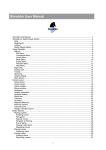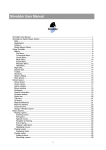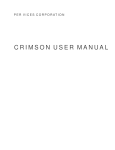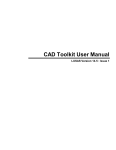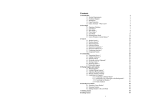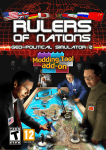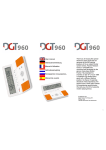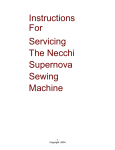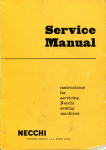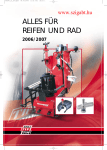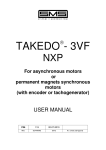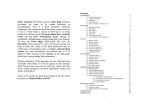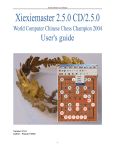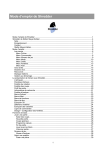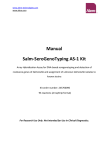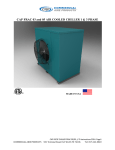Download SHREDDER USER MANUAL.........................................................
Transcript
SHREDDER USER MANUAL ............................................................................................................................ 3 SHREDDER BY STEFAN MEYER-KAHLEN ................................................................................................. 3 NOTE ................................................................................................................................................................... 3 REGISTRATION .................................................................................................................................................... 3 CONTACT ............................................................................................................................................................ 4 STEFAN MEYER-KAHLEN .................................................................................................................................... 4 USING SHREDDER............................................................................................................................................. 5 MENUS ................................................................................................................................................................ 5 Menu Shredder .............................................................................................................................................. 5 Menu File ...................................................................................................................................................... 5 Menu Edit ...................................................................................................................................................... 6 Menu Mode.................................................................................................................................................... 7 Menu Windows .............................................................................................................................................. 8 Menu Help ..................................................................................................................................................... 8 CONTEXT MENU .................................................................................................................................................. 9 GENERAL OPTIONS............................................................................................................................................ 11 SCREEN LAYOUT ............................................................................................................................................ 13 CHESS BOARD ................................................................................................................................................... 13 CLOCKS ............................................................................................................................................................. 13 HISTOGRAM ...................................................................................................................................................... 14 GAME ................................................................................................................................................................ 14 SEARCH INFORMATION ..................................................................................................................................... 15 BASIC FEATURES ............................................................................................................................................ 16 PLAYING A GAME .............................................................................................................................................. 16 Enter Moves................................................................................................................................................. 16 New game .................................................................................................................................................... 16 Special moves .............................................................................................................................................. 16 Shredder is thinking..................................................................................................................................... 16 End of game................................................................................................................................................. 16 Playing a game with black........................................................................................................................... 16 LEVELS ............................................................................................................................................................. 17 Analysis mode.............................................................................................................................................. 17 POSITION SETUP ................................................................................................................................................ 17 Set piece....................................................................................................................................................... 18 Remove piece ............................................................................................................................................... 18 Remove all pieces ........................................................................................................................................ 18 Restore current Position .............................................................................................................................. 18 Button OK inactive ...................................................................................................................................... 18 Castling rights ............................................................................................................................................. 18 GAME HANDLING.............................................................................................................................................. 18 Databases .................................................................................................................................................... 18 Saving games ............................................................................................................................................... 18 Loading games............................................................................................................................................. 19 COMMENTING GAMES ....................................................................................................................................... 19 Entering Variants ........................................................................................................................................ 19 Editing Variations ....................................................................................................................................... 20 ANALYSIS .......................................................................................................................................................... 21 ANALYSIS MODE ............................................................................................................................................... 21 MULTI-VARIANTS MODE .................................................................................................................................. 21 MULTI ENGINE SYSTEM ............................................................................................................................... 22 UCI-ENGINES .................................................................................................................................................... 22 ENGINE OPTIONS ............................................................................................................................................... 22 INSTALL ENGINE................................................................................................................................................ 22 CHANGE ENGINE ............................................................................................................................................... 22 SHREDDER’S ENGINE OPTIONS........................................................................................................................... 23 BOOK OPTIONS................................................................................................................................................ 25 FAQ ...................................................................................................................................................................... 26 SHREDDER ........................................................................................................................................................ 26 How can I load or save a game? ................................................................................................................. 26 What does the information in the Search Information window mean?........................................................ 26 GENERAL .......................................................................................................................................................... 26 Pawn units ................................................................................................................................................... 26 Databases .................................................................................................................................................... 26 PGN ............................................................................................................................................................. 26 EPD ............................................................................................................................................................. 27 Permanent Brain ......................................................................................................................................... 27 ECO ............................................................................................................................................................. 27 Fischer clock ............................................................................................................................................... 27 Endgame Databases .................................................................................................................................... 27 Learning ...................................................................................................................................................... 28 Search depth ................................................................................................................................................ 28 Hotkeys ........................................................................................................................................................ 28 Edit Position ................................................................................................................................................ 28 TIPS AND TRICKS: .......................................................................................................................................... 29 INDEX.................................................................................................................................................................. 30 Shredder User Manual Shredder by Stefan Meyer-Kahlen Shredder Classic 4, Shredder 12 und Deep Shredder 12 are commercial chess programs by Stefan Meyer-Kahlen available on www.shredderchess.com and www.shredderchess.de. This manual gives you all the information you need to use Shredder efficiently for playing and analysing chess games. Note Shredder Classic 4, Shredder 12 and Deep Shredder 12 are copyright protected programs. You can try out the test version of Shredder Classic for 30 days free of charge and without obligation. After 30 days you either need to register or delete Shredder Classic from your hard drive. Test versions of Shredder 12 and Deep Shredder 12 are not available. However the user interface of all three programs is the same; the difference is the integrated chess engine and the available extras for each program. Registration If you would like to use Shredder Classic after 30 days of testing you have to purchase a license code and register it. Shredder 12 and Deep Shredder 12 need to be registered at the first program start with a purchased license key. You will find more information at www.shredderchess.com and www.shredderchess.de (German). If you would like to purchase a license code just click on the Purchase Code button which will automatically bring you to the registration page on the Internet. Directly after your payment is received you will get a license code together with your desired registration name. You have to enter both in the following dialog. You have to enter the name and code exactly as you have received it with your registration. Usually you get your code by email. It is recommended to enter the code in Shredder via the clipboard. To do so mark the code in your email program and copy it with command key+C to the clipboard. Now click in Shredder in the edit field for the code and type command key+V. If you have entered a valid code you should be able to click on the "Register" register button to register Shredder. If this doesn't work please check that you have entered the name and code correctly. After successfully registering Shredder you can use the program without any restriction and of course the dialogs asking you to register won't appear any longer. Contact You can reach the homepage of Shredder on the Internet at www.shredderchess.com and www.shredderchess.de Stefan Meyer-Kahlen Shredder is a series of chess programs by Stefan Meyer-Kahlen. Stefan Meyer-Kahlen has worked on Shredder since 1992. Stefan Meyer-Kahlen, with his computer chess program Shredder, has already won twelve titles as World Computer Chess Champion since 1996. • • • • • • • • • • • • 1996 World Micro Computer Chess Champion in Jakarta 1999 World Micro Computer Chess Champion in Paderborn 1999 World Computer Chess Champion in Paderborn 2000 World Micro Computer Chess Champion in London 2001 World Micro Computer Chess Champion Single CPU in Maastricht 2002 World Computer Chess Blitz Champion in Maastricht 2003 World Computer Chess Champion in Graz 2003 World Computer Chess Blitz Champion in Graz 2004 World Computer Chess Blitz Champion in Tel Aviv 2005 World Computer Chess Blitz Champion in Reykjavik 2006 Chess960 Computer Chess Champion in Mainz 2007 Computer Chess Blitz Champion in Amsterdam Additionally he has achieved further victories and excellent results in important computer chess tournaments, such as the IPCCC in Paderborn or the Open Dutch Computer Chess Championships. The opening book was made by the Italian expert Sandro Necchi and was especially designed to suit Shredder's playing style. Using Shredder Menus You can activate Shredder's functions via the menu at the top of the screen. The following pull-down menus are available: • • • • • • Shredder Menu File Menu Edit Menu Mode Menu Windows Menu Help Menu Some menus contain sub-menus with more commands. You can also call many functions from the context menus which appear when you right click in a window. Menu Shredder Preferences Here you can change here the settings, i.e. engine options, book options, language etc. Shortcut: command key+, Menu File New Game Starts a new game with the last settings, e.g. playing level. You can select if you want to play with the white or black pieces. Shortcut: command key+N Load Game Shows a list of the games in the active database. To load a game double click on its entry in the list. You can reduce the choices with the filter. Shortcut: command key+O Next Game If a game was already loaded you can load the next game in the database using this command. Shortcut: Shift+command key+O Save Game Saves the current game in the active database. Enter the names of the players, the tournament, the venue, the result etc. in the mask. If you enter the complete data it will be easier to find the game later. Shortcut: command key+S Print Game Prints the notation of the current game. Print Position Prints the position. Edit Position Opens the dialog for setting up a position. The current position on the chess board appears as the default position. To enter a piece, click on the desired piece on the right of the chess board. Below the mouse pointer you can see the piece you have selected. Now you can click on any square to place the piece on that square. Shortcut: command key+D Menu Edit Copy Position Copies position to the clipboard. Shortcut: command key+C Copy Game Copies the notation to the clipboard. Shortcut: Shift+command key+C Paste Imports the content of the clipboard into Shredder. This can be either a game in PGN format or a position in EPD format. Shortcut: command key+V Game Details Shows the dialog for entering the game details. Flip Board Turns the chess board and you can play a game with the black pieces from the right side of the board. Shortcut: command key+F Offer Draw You can offer a draw to the program if it is your turn to move. This command is only possible when playing a game. You will receive an answer from Shredder whether the offer was accepted or declined. Resign You can resign a game when playing against the program. Stop Clock Stops the clock. Set Clocks Changes the time on the clock. Take Back All Jumps to the start of the game Take Back Move Takes back the last move Shortcut: left arrow J`adoube If you have entered a wrong move you can take it back. Redo Move Replays the next move form the game Shortcut: right arrow Redo All Jumps to the end of the game. Commenting You can promote lines, add or delete commentaries or you can evaluate positions. Menu Mode Analysis Starts the background analysis of the program. In this mode the engine is not playing any moves. When entering moves or replaying games the engine permanently displays its evaluation of the current position and more info about the search process in the analysis window. Shortcut: command key+A Play against Computer In this mode Shredder plays its moves according to the level set. Shortcut: command key+1 Enter Moves In this mode you can enter moves or games in the program. Shredder is not playing any moves itself and no thinking information will be displayed. Shortcut: command key+2 Compute / Switch Sides Starts the engine to calculate a move. During a game this can be used to switch sides. Shortcut: command key+G Interrupt Interrupts the calculating process of the engine. Shredder plays the best move found so far. This command is only possible if the engine is calculating. Shortcut: command key+I Levels In the levels menu you can define how much time the players are allowed to use. Comparable to a human chess player Shredder plays stronger when it has more time. You can choose between some predefined and adjustable levels. Shortcut: command key+L Blitz Here you can set the time each player is allowed to use for the whole game. Usually the time is set for both players. Increment: the entered value in seconds will be added to the remaining time after every move. This is called Fischer clock. Human Bonus: You can play with more time against Shredder. Timer Per Move In this mode Shredder uses the specified time per move on average. Exceptions: • Shredder is playing moves from his opening book • Shredder has found a mate Time Controls Here you can define up to three different time controls. The third time control will only be available if you have entered a second one. With 'all' you can specify that the time has to be used for the rest of the game. You can also define an increment which will be added to the remaining time after every move. Limit Strength You can reduce Shredder's playing skill to a fixed Elo number. The bigger the number the stronger Shredder is playing. If you want to play against the program it is strongly recommended to adapt Shredder's playing strength to your own skills. Please note that if you set the slider all the way to the right you have not set Shredder to play full strength. To do this you have to deactivate this option. Analyse Game Shredder can automatically analyse the current game and search for mistakes. Shootout The program is playing against itself. You can use this mode to let Shredder finish a game for both sides from a given position. Show your Rating If you play against Shredder set to a fixed strength the program can calculate a rating for you. A symbol in the clock indicates that the current game can still be rated. Menu Windows Board, Clocks, Histogram, Game, Search Information A checkmark shows, that the window is open. All Windows to front Activates all Windows which belongs to Shredder. Layout You can choose different layouts. Analog Clock Shows the analog clock Digital Clock Shows the digital clock Menu Help Hint If it is your turn to move, you can ask Shredder for a hint. Shredder will show its suggested move on the graphical chess board. The hint will be shown with a green arrow. Shortcut: command key+T Show Threat A red arrow shows a threat. Coach is watching Switches the chess coach on or off. The coach will warn you when you have played a weak move. Register Here you can register Shredder with your name and your personal license code. If this command is not available, Shredder and the current engine are already registered. Shredder Homepage Calls the homepage of Shredder on the Internet. Use this to keep track of new developments in Shredder. Context menu Each window has its own context menu. Ctrl+click or right click with the mouse opens a context menu in every window. Context menu in the notation window Move Variation Up Here you can upgrade variations. Delete Variation Variations can be deleted. Delete Rest of Game Deletes the last moves of the selected variations. Enter Comment You can enter a comment for the selected move. Delete All Comments Deletes all comments in the games. Position / Extra Evaluate the positions with special symbols. Remove all variants Deletes all variations. Context menu in the clock window Set Clocks Here you can change or adjust the clocks. Stop Clock Stops the clock. Levels You can set how strong Shredder should play and define different options like time per game, time per move etc. Analog Clock Selects the analog clock. Digital Clock Selects the digital clock. Context menu in the window Search Information Compute / Switch Sides Starts the engine to calculate a move. During a game this can be used to switch sides. Interrupt Interrupts the calculating process of the engine. Shredder plays the best move found so far. This command is only possible if the engine is calculating. Analyse Less Moves Decrease the number of lines to analyse. Analyse More Moves Increase the number of lines to analyse. Engine Options Opens the dialog with the engine options. Context menu in the board window Flip Board Turns the chess board and you can play the game with black from the right side of the board. Edit Position Opens the dialog for setting up a position. The current position on the chess board appears as the default position. To enter a piece, click on the desired piece on the right of the chess board. Below the mouse pointer you can see the piece you choose. Now you can click on any square to place the piece on that square. General Options Animation Speed Adjusts the speed how fast the pieces move on the chess board. If set to fast, the pieces will directly jump from the start to the target square. Language You can choose different languages. Move Sound The program will play a sound if a move is played on the chess board. Show Arrows Activates or deactivates the arrows which shown the last move. Show Legal Moves On lifting a piece, all possible target squares for that piece become highlighted. The colour of the bullets indicates if the piece on that square will be attacked/undefended, defended or if it is not attacked at all. Fast Mouse Input If only one piece can move to a target square it is sufficient to click on the target square to make this move. Example: If you click on e4 in the starting position, the move e2-e4 will get executed instantly. Similarly a clicked piece will move instantly if it only has one legal move. If you turn off this option, you have to click on both the start end target square or drag the piece to its destination. Coordinates Switches the display of the coordinates on the graphical chess board on or off. Boards You can choose different chess boards Piece type You can choose different styles for the pieces. Screen Layout The Shredder display consists of five windows and one menu bar. Each window can be closed or open in the Windows menu. You can change the size of the windows or move them with the mouse. There are different predefined layouts. You can select them in the Windows menu. Chess board The chess board is displayed in 2D. The size of the chess pieces will automatically adapt when you resize the chess board. The colours of the chess board can be changed with the menu Shredder > Preferences > General > Custom. The coordinates, labels of ranks and files on the chess board can be hidden with Menu Shredder > Preferences > General > Coordinates. The last move from Shredder will be shown with a coloured arrow. The arrow will disappear when you move the mouse. Clocks You can see two analog clocks or two digital clocks with green numbers. Histogram The histogram shows the evaluation of Shredder. With the histogram you can, for example, see precisely where mistakes have happened in the game. An advantage for white is shown at the top, an advantage for black at the bottom. By clicking into the window you can directly jump to that specific position. Game This window shows the moves of the game with variations, commentary and the game details. Search Information • • • • • evaluation search depth time best line so far number of the evaluated positions per second The best line so far is displayed in a different color. Basic features Playing a game Enter Moves The easiest way to enter moves is with the mouse on the graphical chess board. Move the mouse to the desired piece, click on the piece with the mouse button and move the piece to the desired square with the mouse button still pressed. New game You can start a new game anytime you want. File > New Game in the menu or use the shortcut command key+N. Special moves • • • • To capture a piece, enter your piece’s move only. To castle, enter the king’s move only. To capture a pawn en passant, enter only the move of the capturing pawn. To promote a pawn, move it to the final rank. This will open up a dialog in which you can select the promotion piece. Shredder is thinking When Shredder is thinking you can see a blinking point in the window search information. When Shredder plays a move, the piece it has moved is marked with a coloured arrow. This shows that it is your turn. The arrow disappears when you move the mouse or touch a key. Some menu commands are not available when Shredder is thinking. They appear in light grey characters (= disabled). You also cannot enter moves until Shredder has moved. At the beginning of a game, Shredder consults its opening book and plays its moves instantaneously. To interrupt Shredder's thinking process at any time choose Mode > Interrupt. Shredder will then play the best move found so far. End of game At the end of a game Shredder displays one of the following messages. • Checkmate • Stalemate! Draw! • Draw! Not enough material left to win! • Draw because of 3rd repetition! • Draw because of 50 moves rule! Playing a game with black You can turn the chess board with Context menu > Flip board or with the hotkey command key+F Let Shredder play a move with Compute from the Mode menu or command key+C Replaying moves You can navigate in the game notation using the navigation buttons in the board window. The buttons are similar to those of a VCR and its meaning should be clear. Taking back and redoing moves • to take back the last move press Left-Arrow. • to redo a move press Right-Arrow. Jump to the start of a game Click on the left button below the chess board to jump to the start of the game. Jump to the end of a game Click on the right button below the board to jump to the end of the game. J`adoube If you entered a wrong move, you can take it back with the arrow button in the middle. Levels With the different playing levels you modify the strength and time usage of the chess program. You can set the level in the menu Mode > Levels Analysis mode In the analysis mode there is no playing level set as there is no time limit. If you set a level in the analysis mode the playing mode will switch to normal. By pressing command key +A or choosing Analyse from the Mode Menu you switch to the analysis mode. In the analysing mode the chess program is continually analysing the position but does not play any move. You can enter moves for both sides and watch the analysis of the engine in the search information window. The analysing mode is the easiest and most comfortable way to analyse games. Position setup You can set up new positions (or modify the current position) on the board at any time. Command key+D to open the dialog for editing the current position. The current position is the default position in the dialog. Set piece To add a new piece, click on the desired piece on the right side of the board. The chosen piece will be shown below the mouse cursor when moving the mouse over the chess board. Click on a square to set the piece on that square. Hint: ctrl + „click“: the piece of the opposite color will be placed on that square. Remove piece To remove a piece from a square, double click on that square. Remove all pieces You can clear the chess board with the button Clear Board. Restore current Position Click on Curr. Position to undo all changes to the current position. Button OK inactive If the button is inactive, the position on the board is not legal. Verify the position on the board and also check the side to move. Clicking on Cancel will discard all changes and close the dialog. Castling rights Here you can define which castling move is still legal in the position on the board. If the buttons are inactive there is no king or rook on the appropriate square. Game Handling Databases Shredder uses the PGN format to save games in databases. A database can contain any number of games. In addition to the moves, more game details (name of the players, site, tournament, ...), comments and lines can be saved. The PGN format is supported by many other chess programs. The data is also stored in plain text format which makes it easy to exchange information between different programs. Saving games To save the current game, choose menu File >Save Game or use the shortcut command key+S. A dialog will be shown where you can enter more details of the game. It is a good idea to enter at least the name of the players and the event data. This will make it much easier to find the game later if you want to load it from the database. Click on Ok to save the game in the current database. If there is no current database set a dialog will appear where you can choose to save the game either in an existing database or in a new database. If you want to change database where you want to save the game you can do so by clicking on „Append to different database“. Loading games To load a game from a database choose menu File >Load Game or use the shortcut command key + O. Select one game with the mouse and click on Load to load the game. You can also double click on the name to load it. You can limit the choice by a filter where you can search only for the name, or result, year etc. You can search for the initial letter or a part of a word. After loading one game from a database you can load the next and previous game in the database by selecting Menu File > Next Game. Commenting games With Shredder you can add comments and different lines (alternative moves) to a game. To enter or edit comments choose "Enter Comment" from the context menu of the Game window or use Menu Edit > Commenting You can enter text comments as well as special symbols for moves and positions. Entering Variants If you are entering a new move via mouse when replaying a game, a dialog will appear asking whether you want to add the new move as a new line. You have the following possibilities: • New Line • New Main Line • Overwrite • Cancel Editing Variations You can delete lines, change their order or cut lines. • • • To delete a line go to any move in the line and choose Menu Edit > Commenting > Delete Variation To move a line up choose Menu Edit> Commenting > Move Variation Up To delete the rest of the line go to the last move you would like to keep and choose Menu Edit > Commenting > Delete Rest of Game Analysis Analysis mode With command key + A or Analysis in the Mode menu you can switch on the analysis mode. In the analysis mode the chess program continually analyses the position but is not playing any move. You can enter moves for both sides and can constantly watch the analysis of one or more engines. The analysis mode is the easiest, most common and most comfortable method for analysing. Multi-Variants Mode When analysing a position, Shredder can not only search for the best move but also analyse any number of moves. In the context menu you can increase the number of moves to analyse. The program will display a list of the best moves found together with the evaluation and main line. You can decrease the number of moves again in the context menu. The larger the number of moves to analyse, the slower the analysis will be. Therefore you should disable the multi-line analysis if you only want to know only the best move. Multi Engine System Shredder was designed as a multi-engine system. This means that the user interface and the chess engine are strictly separated. They communicate via a specially designed protocol. This way you can use different chess engines in one user interface. Shredder supports UCI engines. UCI-engines UCI stands for Universal Chess Interface. It was developed by Stefan Meyer-Kahlen and Rudolf Huber and is similar to the Winboard interface but has numerous advantages. • • • UCI engines are automatically detected and installed by Shredder. UCI engines can be configured with standardised dialog masks. Neither basic nor engine specific functions need external configuration dialogs. UCI engines have access to all functions of the Shredder interface. You can find the documentation of the UCI protocol at www.shredderchess.com. Engine options UCI engines can have engine options which allow changing certain parameters in the engine. They can be easily modified in the integrated dialog box. Some possible options are: • the evaluation of every piece • the evaluation of king safety • selectivity • draw value • learning The engine option dialog varies from engine to engine. Here are the details for the Shredder engine. In Shredder, engines are represented by a file with the .eng file extension. You can modify the options of any engine and save it as a new engine. Those engines will be treated like real engines in the engine dialog boxes. Install engine Menu Shredder > Preferences > Install new engine This function installs an engine in the Shredder user interface. To install an engine in Shredder to the following: • Choose Install Engine from the Engines menu in the Extras menu. • Choose the path to the engine • Set the names of the engine and author. After these steps the engine can be loaded in Shredder. Change engine Replaces the active engine with a new one. Menu Shredder > Preferences you can choose an engine. Shredder’s engine options Keep Hash Tables: Shredder is never clearing his internal hash tables -> this is good for games and analysis. Position Learning: Shredder remembers positions he has already analysed and played. With this option Shredder is trying to learn from his mistakes. Use Tablebases: Set how Shredder is using the Nalimov endgame databases in its search. Never: Shredder never accesses the endgame databases Late: Shredder accesses them late and will not be slow down much. Normal: Shredder accesses them reasonably. Early: Shredder accesses them early and can sometimes be slow down a lot Use Shredderbases: Set how Shredder is using the Shredderbases in its search. Never: Shredder never accesses the Shredderbases LikeTB: Shredder accesses them as often as the Nalimov endgame databases. Normal: Shredder accesses them almost everywhere. Always: Shredder accesses them everywhere Contempt This specifies how Shredder is evaluating a draw. If the value is greater than 0 Shredder is playing to win, if the value is below 0 a draw is often good enough. Clear Hash: After clicking on OK the internal hash tables are cleared. This option helps to get reproducible results. Clear PosLearning: Clears the file with all learned data from the hard disk. Shredder is loosing his learned knowledge. Values for the pieces: Specifies the extra value of the pieces. The default value for a pawn is 100. For example if Shredder is sacrificing too many pawns you can set the extra value for pawns to 10. If you set the value below 0 Shredder is more willing to sacrifice pawns. You can also set the values of Shredder’s pieces independently on the value of Shredder’s opponent’s pieces. Weights for the evaluation parameters: You can set the weight in % for the most important evaluation parameters in Shredder. King Safety Sets the parameter for king safety Center Control Sets the parameter for center control Pawn Structure How should Shredder evaluate certain pawn patterns on the board? Passed Pawns If for example you think that Shredder is over evaluating passed pawns you can set this value to 90 %. Bishop Pair How much extra should Shredder evaluate the bishop pair Time Buffer The extra time in seconds that Shredder will always keep on his clock. Time Usage With bigger values Shredder is playing slower but will certainly obey the time controls. Threads (only Deep Shredder) Sets the number of processors Shredder should use on a multi processor machine. The more processors Shredder is using, the faster and more efficient he can calculate. Book Options You can change the options for the opening book in the Book Options tab in the Preferences dialog. There are 4 settings: • • • • Only Best Move: only the best move will be played Tournament: only good moves will be played and better moves will get a higher priority Standard: only good moves will be played Wide: all moves have the same weight and will be play with the same probability Here you can also change the opening book to a different book by clicking on Change Book. FAQ Shredder How can I load or save a game? In the menu File > Save Game you can save the current game in a PGN database With Menu File > Load Game you can load a game from a PGN database. What does the information in the Search Information window mean? In the window search information you can see the following information: • • • Evaluation in pawn units Search septh Current line I always lose against Shredder. In the Menu Mode > Levels, you can reduce Shredder's playing strength. It is highly recommend to use the limit strength feature when you play against Shredder yourself. General Pawn units A chess program evaluates positions in pawn units. Here are the values for each piece on the board. • • • • • Queen 9 pawn units Rook 5 pawn units Bishop 3 pawn units Knight 3 pawn units Pawn 1 pawn units Positional factors are evaluated in fractions of a pawn. Databases The following file standards are supported by Shredder. PGN The PGN format is widely used on the Internet. In addition to chess moves a lot of information (players, venue, year, result, opening code, comments, variations etc.) can also be stored. Games are stored as text, so that a PGN database can be edited with any word processing program. Here is an example of a game in PGN: [Event "18th WMCC"] [Site "Maastricht"] [Date "2001.08.23"] [Round "8"] [White "Shredder"] [Black "Chess Tiger"] [Result "10"] 1. d4 d5 2. Nf3 Nf6 3. e3 Bf5 4. Bd3 Bxd3 5. Qxd3 Nbd7 6. OO e6 7. Nc3 c5 8. e4 cxd4 9. Nxd4 dxe4 10. Nxe4 Be7 11. Be3 OO 12. Rad1 Qa5 13. Nxf6+ Nxf6 14. Qb3 Nd5 15. Qxb7 Rab8 16. Qd7 Rfd8 17. Nc6 Rxd7 18. Nxa5 Rxb2 19. c4 Nf6 20. Nc6 Bf8 21. Rxd7 Nxd7 22. Ra1 Bc5 23. Nxa7 Bxe3 24. fxe3 Ne5 25. a4 h5 26. a5 h4 27. h3 Nxc4 28. a6 Nb6 29. Nc6 Kh7 30. a7 Na8 31. Nd8 Kg6 32. Ra4 e5 33. Rxh4 Ra2 34. Nc6 Ra6 35. Nxe5+ Kg5 36. Rg4+ Kf6 37. Nd7+ Ke7 38. Nb8 Ra1+ 39. Kh2 Kd6 40. Rd4+ Kc7 41. Rd7+ Kb6 42. Rxf7 Rxa7 43. Nd7+ Kc6 44. Ne5+ Kb6 45. Nc4+ Ka6 46. Rxa7+ Kxa7 47. h4 Kb8 48. Nd6 g6 49. Nf7 10 You can cut and paste this game into Shredder. Shredder can load and save game collections in PGN format, and is also able to search for specific game information in any PGN database file. EPD An EPD file is an ASCII text file which stores chess position. The board is described first. The upper case letters PNBRQK represent the white pieces, and lower case represent black pieces. Numbers indicate a series of empty squares from 1 to 8. The board description starts at a8 to h8, then a7 to h7 etc. The separation of each rank is marked by a slash. The side to move is next. It is separated from the board description by one space character and consists of "w" or "b", indicating White or Black to move. Next are the castling rights, again separated by a space. "Q" indicates that white can castle queen side, "K" that he can castle king side. The lower case letters are used if black can castle. If neither side can castle at all only a hyphen is used. Finally the square on which a pawn can be captured en passant is given, in algebraic notation. If white is to move this string can only be a5, b5, c5, etc., or a hyphen if no pawn can be captured en passant. Likewise with black to move this string must be a4, b4, c4 etc., or a hyphen. Here's an example of an EPD position: 8/2p5/7p/pP2k1pP/5pP1/8/1P2PPK1/8 w – id “BS-06“;c0 “f2-f3! wins“ Permanent Brain "Permanent brain" is the name given to the function that causes the computer to think during the opponent's time. Essentially a chess engine will try to guess what the opponent is going to play and prepare a reply before he has finished thinking about it. If the opponent plays the move that the computer expects, the computer may reply very quickly or even immediately. If the opponent makes another move the computer will have to forget its permanent brain calculations and start thinking about its next move again. This is the reason why Shredder will sometimes reply instantly, even on slow playing levels. You can watch the permanent brain calculations in the engine window. The information is displayed in light grey text. It is advisable to switch permanent brain off if you wish to carry out timing tests, for example, to see how long the Shredder engine takes to solve a particular test position. If permanent brain is on you will not get consistent results, since Shredder may have already been calculating the position before you started the test. In order to get the most stable results in computer tests you should switch off permanent brain and clear the hash tables. ECO The ECO (Encyclopaedia of Chess Openings) code is a system to classify chess opening. Each ECO code has a letter from A to E and a number from 00 to 99. Fischer clock The Fischer clock was invented by former chess champion Bobby Fischer. For every move the players will get a time bonus to avoid time trouble. You can use the Fischer clock in Shredder. Endgame Databases Many chess programs can play all important major piece endings with three, four and five men on the board perfectly. This is to be taken literally. The endgame databases contain full information on every legal position that is possible in these endings. At any stage, the program knows whether the position is won, lost or drawn, and how many moves it takes to win or lose (assuming perfect play by both sides). In computer chess there are two different types of endgame databases that are being used at the present time: • The Thompson databases, generated by Ken Thompson • The Nalimov endgame tablebases, generated by Eugene Nalimov Shredder uses the Nalimov tablebases. It consults these during the search and it can use them in a special endgame oracle that allows you to study endgames in a unique manner. Nalimov tablebases These endgame databases were introduced in 1998 and are generally referred to as "tablebases". The currently available tablebases contain every possible position in every relevant four and five piece endgames. Together with each position there is information on whether it is a win, loss or draw. If a position is a win or a loss there is information on the maximum number of moves required up to mate. A chess playing program using the Nalimov tablebases will end many games with truly spectacular mate announcements. Shredder will often confront you with a "mate in 45 moves", even when there are many more pieces on the board. This is because the program has found a line in which it can trade down to five pieces and then get a position which is recorded in the tablebases as a forced win. Learning Shredder has various learning functions. The learning has the following targets: • Improved game play and analysis • Recognition of combinations Search depth Shredder can calculate a number of moves ahead. The number of moves in this calculation is called the search depth and is measured in plies. A ply is one move from either white or black. Thus each move consists of two plies. Hotkeys New Game Quit Save Game Preferences Copy Game Flip Board Take Back Move Play Against Computer Compute / Switch Sides Levels Command key+N Command key+Q Command key+S Command key+, Shift+Command key+C Command key+F Left arrow Command key+1 Command key+G Command key+L Edit Position Load Game Next Game Copy Position Paste Analysis Redo Move Enter Moves Interrupt Show Threat Command key+D Command key+O Shift+Command key+O Command key+C Command key+V Command key+A Right arrow Command key+2 Command key+I Command key+T Tips and tricks: Tip 1: You play against Shredder and lose most of the games? No problem, you can set Shredder to any playing strength you like. Simply use the limit strength option in the different level dialogs. Tip 2: You do not like the different coloured arrows and dots on the chess board when playing against Shredder? Simply disable the features you do not like in the Preferences dialog. Tip 3: It is always a good idea to use the right mouse button in Shredder. Many features and functions are available via the context menu which will appear when you click with the right mouse button. If your mouse has just one button you can also keep the Ctrl key pressed and use the left mouse button. Tip 4: If you want Shredder to play a greater variety of opening lines, you can change the book mode to “Wide” in the Book Options section in the Preferences dialog. Please note that Shredder will also play some inferior lines in this mode. Tip 5: The layout of the different windows in Shredder can be changed according to your preferences. Simply resize any window in Shredder with the mouse. You can also use one of our predefined layouts in the Windows menu. Tip 6: The chess pieces and the chess board as well as all colours and graphics can be changed in Shredder. Simply change what you do not like in the Preferences dialog. Tip 7: You can select “Hint” from the Help menu anytime to get advice about which move to play in the current position on the board. Use this when playing against Shredder and you are running out of ideas. Tip 8: When you play against Shredder, you can tell it to display a warning each time you have entered a bad move. Shredder will warn you and will suggest a better move for you. Use “Coach is Watching” from the Help menu to activate this feature. Tip 9: With “Mode -> Analysis” from the main menu you can switch on the analysis mode in Shredder. In this mode Shredder will never execute a move himself but will always start his analysis for the current position on the chess board. This way you can manually replay a game or enter new lines on the board and Shredder will always give you his evaluation for the current position. Tip 10: You can let Shredder automatically analyse games. Enter of load a game to analyse and select “Analyse Game” from the Mode menu. Shredder will add his comments to the game and show you where better moves could have been played. Tip 11: Did you know that you can access our online endgame database with all 6 men chess endgames directly from Shredder? You will instantly get the exact score for every possible position. Just setup a position with 6 or fewer pieces on the board and click on Online EGTB in the Search Information windows and then on the Online button. Shredder will then display all legal moves together with their score. Tip 12: Did you know that you can access our online opening database with more than 16 million chess moves? Setup a position from the opening or early middle game and click on Book Moves in the Search Information windows and then on the Online button. You will instantly get the statistics for all moves that have ever been played in the current position. Index Analysing mode 17 Analysis 7 Analysis mode 21 Blitz 7 Book Options 25 change engine 22 Chess board 13 Clocks 13 Commenting 19 Contact 4 Context menu 9 Learning 28 Load Game 5 Menu Edit 6 Menu File 5 Menu Help 8 Menu Mode 7 Menu Shredder Classic 5 Menu Window 8 Menus 5 Meyer-Kahlen 4 Multi-Variant analysis 21 New Game 5 Note 3 Databases 18 Options 11 ECO 27 Edit Position 5 End of game 16 Endgame Databases 27 Engine options 22 Enter Moves 7, 16 Entering Variants 19 EPD 27 Fischer clock 27 Flip Board 10 Game 14 Pawn units 26 Permanent Brain 27 PGN 26 ply 28 Position setup 17 Registration 3 Save Game 5 Search depth 15, 28 Search Information 15 Shredder’s engine 23 Special moves 16 Histogram 14 Hotkey 28 Tablebases 28 Install engine 22 UCI-engine 22 Layout 8






























